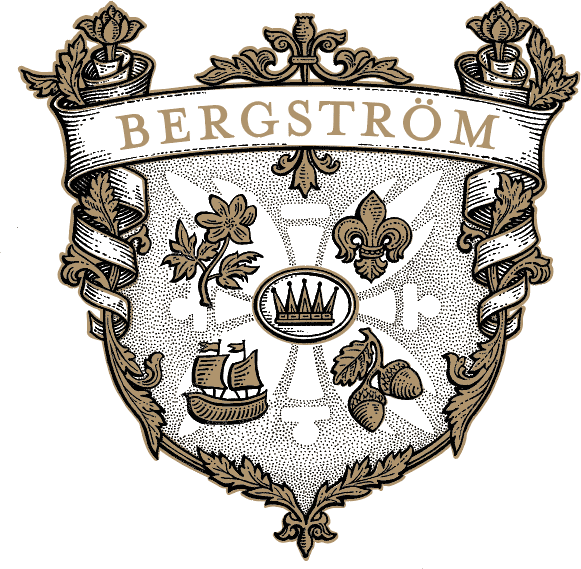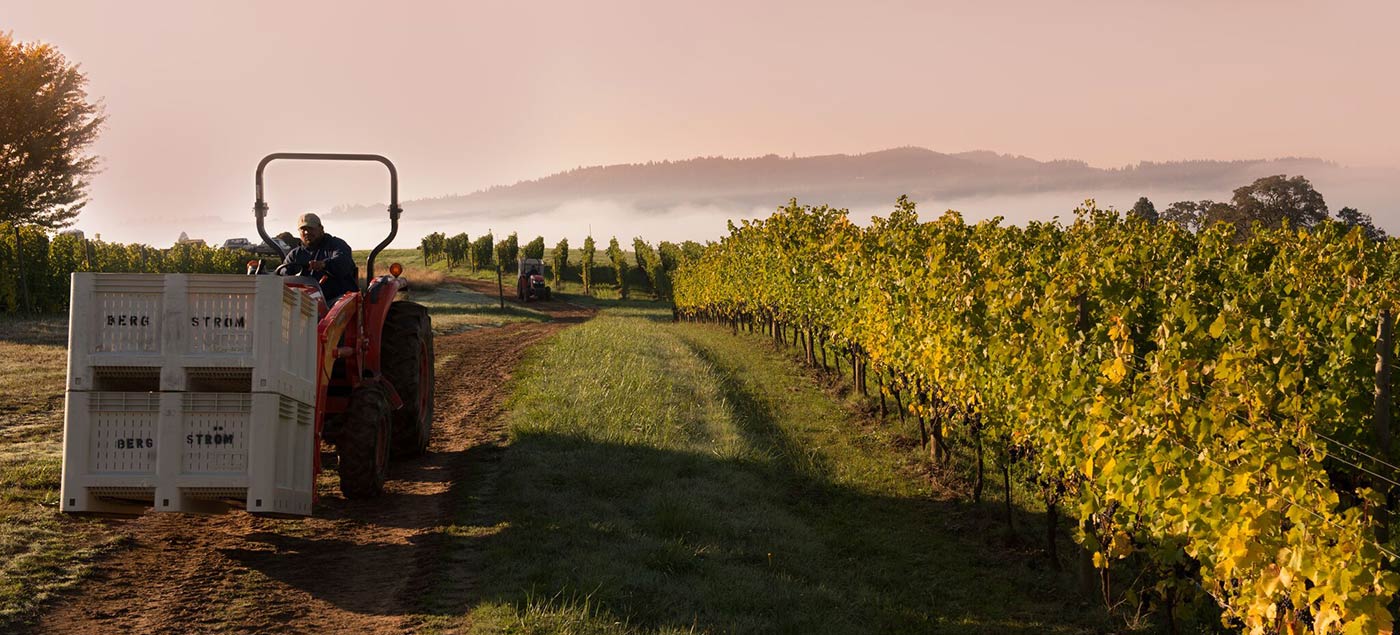I don’t know if it was the abundance of music that we played this year during harvest or just the feel of the year but the way this vintage unfolded, I can’t help but think of a Paul Simon lyric to best describe the 2013 experience: “And she said ‘Honey take me dancing’ but they ended up by sleeping in a doorway. By the bodegas and the lights on upper Broadway, wearing diamonds on the soles of their shoes.”
Preparing for a sun-soaked harvest which was tracking identically to the warmer years of 2006 and 2009, I don’t think we truly realized what we were in for. But then again, in the Willamette Valley, no two vintages are alike and hoping that a vintage will be similar to another year in the past can only lead to ruin. But 2013 was far from a ruinous vintage. It was just different than anybody thought it would be. And that is why it could end up being very special.
Here is how 2013 unfolded at Bergstrom Wines:
After a long and dry year, one of the driest on record, many said that the degree days and heat units were tracking almost identically with 2006 and 2009, two very warm vintages that were marked by dryness and heat spikes at the end of the year which drove sugars up and drove acidities down. The 2006 and 2009 wines were flattering from the best addresses but most of them were high in alcohol and stewy with jammy flavors and even some green and bitter aspects to the wines due to tannins and other phenolic materials in the grape not ripening at the same pace as the rapidly escalating sugars and free falling acidities. Personally when I heard people say that we were on track with those years, I felt a pang in my heart as the warmer years in the Willamette Valley are not my favorite. Trying to make harmonious wines with balanced acidities and alcohol levels and capturing freshness in the fruit is very difficult to do in warm or hot years.
So we did what we do every year and that was to prepare for the worst and hopefully be pleasantly surprised. This is a technique that I find works especially well in Oregon. If you take yields down to respectable levels regardless if the year is hot or cold, early or late, you can better deal with the outcome. High yields of fruit can only ripen in the longest and/or warmest of years, which we do not get that often. As well, we had to work hard in the early season with shoot positioning, ground work and organic/biodynamic sprays to ensure that we made it through the mildew season clean and ready for whatever Mother Nature would throw our way.
The vines were beginning to stress and leaves were beginning to turn color in the fruit zone in the month of August which was worrisome. A good spout of rain right around Labor Day really helped to get the vines back on track and photosynthesizing again which is exactly what we needed.
On September 13th a forecast came across the wire that called for a large amount of rain on the horizon and potentially weeks of cloudy wet cooler weather. Normally I don’t balk when confronted with these kind of weather reports early in the season. But because of our early spring and flowering, we were already at 100 days past bloom in several vineyard sites which is more than adequate time to ripen Pinot Noir and especially Chardonnay. Brix levels were hovering around 22 degrees, pH’s in the Chardonnays were 3.1-3.15 and with some of the Pinot Noirs 3.3-3.4. In other words, Perfect for what I was looking for. The rain was coming and we had 50 acres of fruit that were ready to come in. So on September 15th we began to harvest our younger vines and warmer sites for Pinot Noir and most of our Chardonnay from almost all of our vineyards. We pushed hard for 5 days and brought all of the fruit in under cloudy but mostly dry skies. We harvested all of the Bergstrom Vineyard in the Dundee Hills AVA, we harvested the Winery Block just out front of the winery and tasting room. We harvested half of Le Pre du Col on the Ribbon Ridge and sixty percent of Shea Vineyard in Yamhill Carlton. We harvested all of our Chardonnay except for Temperance Hill, Wren and Gregory Ranch. 112 tons of fruit in all were harvested before the rains fell.
The rain came in like a lion over the weekend of September 27th dropping more than 6 inches of rain in just over 5 days. Some towns and the vineyards around those towns saw less rain, some saw more. Some vineyards handled the rain very well and others did not fare as well. Many Oregon winemakers had picked a large amount or all of their fruit before the rain and yet many more had decided to only pick a small amount if anything before the rains. I know of many very talented winemakers in the Willamette Valley who chose to wait on their entire harvest. We had picked 50% of our grapes before the harvest. And I can honestly tell you that I couldn’t sleep for many nights because I was worried that I might have pulled the trigger too soon.
I have slowly been transitioning my wines and my wine style away from the big Hollywood production and more towards the independent film made by the starving artist. More and more I want to make Oregon Pinot Noirs and Chardonnays that walk on the cutting edge. I want to make wines that take time to open and years to develop and only truly showcase their greatness after a decade or more in the bottle. To do this you must have freshness and harmony within the balance between acid, fruit and alcohol. And to achieve all of this, I have found that I need to pick slightly earlier than I have been in the past as only natural acids and lower pH’s can keep wines vibrant and youthful. And if you balance your farming and yields and winemaking techniques correctly, you can still have wines of opulence and flesh that are enthralling to drink young, but now you can bring in the other dimension of succulence and vibrancy and youthful structure that will reward the patient wine drinker with time in the cellar.
So anyway, I picked earlier than I ever had before from some very important vineyards and my head was full of worry and self-doubt about this decision. I knew deep down that I was doing the right thing. I checked and double checked my notes and it all looked right on paper. And then I tasted the first few wines as we pressed out the first tanks and they were exhilarating. And then another and another wine went to barrel and I had a big smile on my face and I slept very soundly after that. The early showing from 2013 was everything that I had hoped they would be.
The rain passed and with its passing came one of the most beautiful fall seasons that I can remember in Oregon. weeks upon weeks of sunshine, warm temperatures and leaves on vines and trees bursting into vivid reds, oranges, pinks and yellows. For about a month it was paradise on earth in the Willamette Valley and during this window we harvested the rest of our fruit. The fruit that came in during the second pick was all across the board as far as its appearance, but the quality and flavors and phenolic ripeness was quite good. This fruit after all had sat on the vines for more than 120 days past bloom. That is as long of a season as 2011 or 2012. And with Pinot Noir, we know now that it isn’t so much about sunshine and warmth as it is about hang time on the vine.
The interesting thing about this second round of harvesting is that it was now almost three weeks after we first started picking. All of the fermentation tanks that we had filled up with the first round of fruit had already finished fermenting and we had taken those wines to barrel. It was as if we were starting our second harvest of the year.
Today is November 9th and we have only one tank left to press out in the winery. All of our Pinot Noir has been taken to barrel as of yesterday. The Chardonnays are enjoying a long, slow healthy fermentation in their barrels. Those beautiful bright leaves of autumn are long gone, brown and wet on the ground. The clear blue skies are also gone, giving way to wintery gray cloud cover. The birds came and went but they missed the harvest this year by about 2 weeks. Lucky for us. Our hard working team of interns has also left which is always bittersweet. We had a great group of guys this year who all worked very hard.
Now all that is left to do is clean and organize and taste through what we have crafted and wrap our heads around what we did this year. Harvest is always a celebration at Bergstrom Wines and so it is with great prejudice that I say; I feel that this was a wonderful year. We laughed and played and ate and drank and worked so hard and it all felt right. The grapes were beautiful and full of flavor with the right levels of acidity and sugar for my taste. Our vineyards were pristine and stayed free of disease from the start of the year to the finish thanks to the hard work of our vineyard team. We worked from sun up to sun down for more than 50 straight days and it was worth it. We picked at the right time and we balanced the harvest out with a large picking campaign before and after the rains. I stayed true to my goals for the year and implemented a lot of whole cluster fermentations and a more delicate approach to extraction. The cellar is full of wines that are as complex as the year was.
A friend of mine on social media likened the 2013 vintage to a perfect combination of 2011 and 2012. I like this comparison although I try to stay away from comparing vintages too much, especially this early on. In reality, 2013 is unlike any other vintage we have ever seen. The wines are deeply colored, very aromatic and have a wonderful, charming fruit forwardness that will undoubtedly make the vintage very friendly and playful. But certain vineyards have given serious tannic and mineral structure that will keep these wines honest. These are not wines that are thin or washed out as some might assume given the rains that fell in the middle of the vintage. In fact, I don’t think that the rain played much of a role at all other than knocking dust off of the vines and giving the vines’ parched roots a well-deserved drink of water. The wines from the first half of harvest and the second half of harvest will no doubt be quite different from each other. But through blending in the cellar we will arrive at an even greater level of complexity from this “double harvest” phenomenon.
And so the harvest we thought we would have did not turn out to be the harvest we had and the diamonds on the soles of our shoes will quite possibly be Oregon’s best kept secret time and time again: that the challenging vintages often times make the greatest wines. And everybody here knows what I am talking about.


